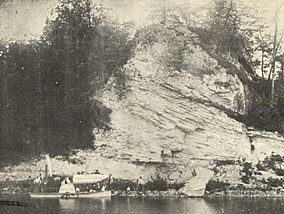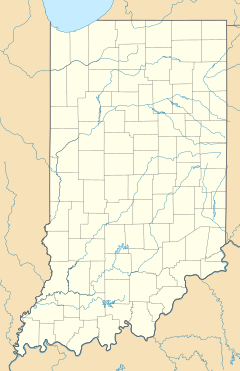Hanging Rock and Wabash Reef National Natural Landmark facts for kids
Quick facts for kids Hanging Rock and Wabash Reef National Natural Landmark |
|
|---|---|

Early postcard photo of Hanging Rock
|
|
| Location | Wabash County, Indiana, United States |
| Area | 4 acres (1.6 ha) |
| Established | 2009 |
| Designated: | 1986 |
Hanging Rock National Natural Landmark is a special place in Wabash County, Indiana. It covers about 4 acres (1.6 hectares) of land. This site was officially named a National Natural Landmark in May 1986.
You can find Hanging Rock on the south bank of the Wabash River, close to the town of Lagro. What makes it so amazing is a huge natural display of fossilized coral reef. This reef is incredibly old, dating back to the Silurian Period, which was about 400 million years ago!
The rock formation is made of limestone. It rises about 75 feet (23 meters) above the river. The river's water has slowly worn away the bottom part of the rock. This makes the top part look like it's "hanging" over the water.
Hanging Rock is owned by a group called Acres Land Trust. It is open for everyone to visit from sunrise to sunset. To help keep this natural wonder safe, camping and littering are not allowed.
Contents
What is a National Natural Landmark?
A National Natural Landmark (NNL) is a site in the United States that has unique natural features. These features can be geological, biological, or both. The program aims to protect and preserve the best examples of America's natural heritage.
Hanging Rock was chosen because it shows a fantastic example of an ancient coral reef. It helps scientists and visitors understand what Earth was like millions of years ago.
The Ancient Coral Reef
Imagine a time when Indiana was covered by a warm, shallow sea! That's what it was like during the Silurian Period, about 400 million years ago. In those seas, tiny sea animals called corals built huge reefs, much like the coral reefs we see in oceans today.
Over millions of years, these coral reefs died and were covered by layers of mud and sand. The mud and sand eventually turned into rock, and the corals turned into fossils. This process is called fossilization.
At Hanging Rock, you can see these ancient fossilized corals. They are preserved in the limestone rock. It's like looking at a snapshot of a prehistoric ocean! Scientists study these fossils to learn about Earth's past climates and life forms.
How Hanging Rock Got its Name
The Wabash River has been flowing past this rock for a very long time. The river's water slowly erodes, or wears away, the softer parts of the limestone cliff. The bottom part of the cliff near the river gets worn away faster than the top part.
This constant wearing away by the river creates an overhang. The upper part of the rock sticks out, looking like it's "hanging" over the river. This natural process is what gives Hanging Rock its unique and memorable name.
Visiting Hanging Rock
Hanging Rock is a great place to visit if you love nature and history. You can walk along the river and see the impressive rock formation up close. It's a chance to connect with millions of years of Earth's history.
Remember to be respectful of the site. Stay on marked paths and take all your trash with you. By doing so, you help protect this amazing natural landmark for future generations to enjoy.
External Links
- Acres Land Trust's Virtual Hike of Hanging Rock on YouTube.
- National Park Service Hanging Rock National Natural Landmark


